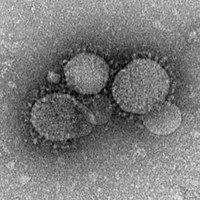
Photo from wikipedia
Objectives Duration of SARS-CoV-2 in upper respiratory tract is extremely variable, but its relation to disease severity is unknown. We investigated such relation in the 530,000-inhabitant North-Eastern Italian province of… Click to show full abstract
Objectives Duration of SARS-CoV-2 in upper respiratory tract is extremely variable, but its relation to disease severity is unknown. We investigated such relation in the 530,000-inhabitant North-Eastern Italian province of Udine. Methods We analysed real‐time reverse‐transcriptase polymerase chain reaction (RT-PCR) tests for SARS-CoV-2 on upper respiratory specimens conducted at the Virology Laboratory of the University Hospital of Udine, Italy, serving the whole province, from March 1 to April 30, 2020, on positive subjects of four groups characterized by different disease severity (critically ill patients admitted to Intensive Care Units, patients admitted to Infectious Disease Units, symptomatic patients visited at the Emergency Department and not hospitalized, and asymptomatic subjects tested during contact tracing or screening activities). Duration of viral positivity was assessed from the first positive test to the day of the first of two consecutive negative tests. Univariate and multivariate analyses were conducted to investigate differences in the four groups. Results From March 1 to April 30, 39,483 RT-PCR tests for SARS-CoV-2 were conducted on 23,778 persons. 974 subjects had a positive test result. Among those with multiple tests (N=878), mean time to negativity was 23.7 days (standard error 0.3639) (median 23, interquartile range: 16-30 days). Mean time to negativity was longer in the ICU group than in the others, whereas no difference was observed between asymptomatic patients and those with mild disease. Conclusions Disease control measures should not be adjusted to account for differences in viral shedding according to symptomatic status.
Journal Title: Clinical Microbiology and Infection
Year Published: 2020
Link to full text (if available)
Share on Social Media: Sign Up to like & get
recommendations!